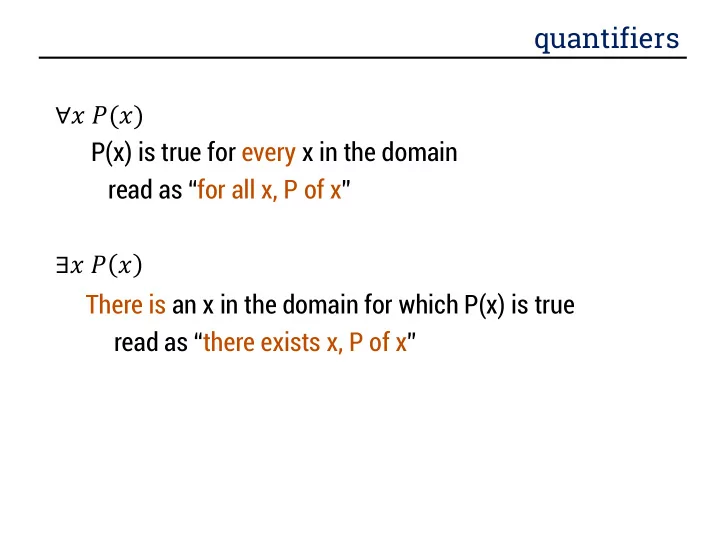

quantifiers ∀𝑦 𝑄(𝑦) P(x) is true for every x in the domain read as “ for all x, P of x ” ∃𝑦 𝑄 𝑦 There is an x in the domain for which P(x) is true read as “ there exists x, P of x ”
negations of quantifiers • not every positive integer is prime • some positive integer is not prime • prime numbers do not exist • every positive integer is not prime
negations of quantifiers • x PurpleFruit(x) Domain: Fruit • “All fruits are purple” • What is x PurpleFruit(x) PurpleFruit(x) • “Not all fruits are purple” How about x PurpleFruit(x)? • • “There is a purple fruit” • If it’s the negation, all situations should be covered by a statement and its negation. • Consider the domain {Orange}: Neither statement is true! • No. How about x PurpleFruit(x)? • • “There is a fruit that isn’t purple” • Yes.
de M organ’s laws for quantifiers x P(x) x P(x) x P(x) x P(x)
de Morgan’s laws for quantifiers x P(x) x P(x) x P(x) x P(x) “ There is no largest integer. ” x y ( x ≥ y) x y ( x ≥ y) x y ( x ≥ y) x y (y > x) “ For every integer there is a larger integer. ”
scope of quantifiers example: Notlargest(x) y Greater (y, x) z Greater (z, x) truth value: doesn’t depend on y or z “ bound variables ” does depend on x “ free variable” quantifiers only act on free variables of the formula they quantify x ( y (P(x, y) x Q(y, x)))
scope of quantifiers x (P(x) Q(x)) x P(x) x Q(x) vs.
cse 311: foundations of computing Spring 2015 Lecture 6: Predicate Logic, Logical Inference
nested quantifiers • B ound variable names don’t matter x y P(x, y) a b P(a, b) • Positions of quantifiers can sometimes change x (Q(x) y P(x, y)) x y (Q(x) P(x, y)) • But: order is important...
predicate with two variables y P(x, y) x
quantification with two variables expression when en true when en false x y P(x, y) x y P(x, y) x y P(x, y) x y P(x, y)
∀𝑦 ∀𝑧 𝑄(𝑦, 𝑧) y x
∃𝑦 ∃𝑧 𝑄(𝑦, 𝑧) y x
∀𝑦 ∃𝑧 𝑄(𝑦, 𝑧) y x
∃𝑦 ∀𝑧 𝑄(𝑦, 𝑧) y x
quantification with two variables expression when en true when en false x y P(x, y) x y P(x, y) x y P(x, y) x y P(x, y)
logal inference • So far we’ve considered: – How to understand and express things using propositional and predicate logic – How to compute using Boolean (propositional) logic – How to show that different ways of expressing or computing them are equivalent to each other • Logic also has methods that let us infer implied properties from ones that we know – Equivalence is only a small part of this
applications of logical inference • Software Engineering – Express desired properties of program as set of logical constraints – Use inference rules to show that program implies that those constraints are satisfied • Artificial Intelligence – Automated reasoning • Algorithm design and analysis – e.g., Correctness, Loop invariants. foundations of rational thought… • Logic Programming, e.g. Prolog – Express desired outcome as set of constraints – Automatically apply logic inference to derive solution
proofs • Start with hypotheses and facts • Use rules of inference to extend set of facts • Result is proved when it is included in the set
an inference rule: Modus Ponens • If p and p q are both true then q must be true p, p q • Write this rule as ∴ q • Given: – If it is Monday then you have a 311 class today. – It is Monday. • Therefore, by modus ponens: – You have a 311 class today.
proofs Show that r follows from p, p q, and q r 1. p given p q given 2. q r 3. given 4. q modus ponens from 1 and 2 5. r modus ponens from 3 and 4
proofs can use equivalences too Show that p follows from p q and q p q 1. given q 2. given q p 3. contrapositive of 1 p 4. modus ponens from 2 and 3
inference rules A, B • Each inference rule is written as: ∴ C,D ...which means that if both A and B are true then you can infer C and you can infer D. – For rule to be correct (A B) C and (A B) D must be a tautologies • Sometimes rules don’t need anything to start with. These rules are called axioms: – e.g. Excluded Middle Axiom ∴ p p
simple propositional inference rules Excluded middle plus two inference rules per binary connective, one to eliminate it and one to introduce it: p q p, q ∴ p q ∴ p, q p q , p p x ∴ p q, q p ∴ q p q p, p q Direct Proof Rule ∴ p q Not like other rules ∴ q
important: applications of inference rules • You can use equivalences to make substitutions of any sub-formula. • Inference rules only can be applied to whole formulas (not correct otherwise) e.g. 1. p q given 2. ( p r) q intro from 1. Does not follow! e.g . p=F, q=F, r=T
direct proof of an implication • p q denotes a proof of q given p as an assumption • The direct proof rule: If you have such a proof then you can conclude that p q is true Example: proof subroutine 1. p assump umption tion 2. p q intro for from 1 3. p (p q) direct proof rule
Recommend
More recommend